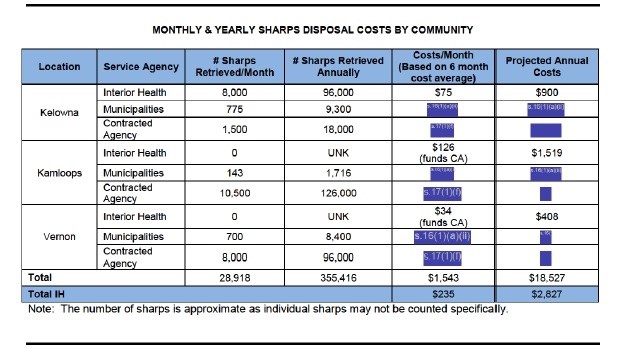
(BRENDAN KERGIN / iNFOnews.ca)
July 17, 2018 - 6:30 PM
HOW INTERIOR HEALTH CALCULATED ITS CLAIM THAT 99 PER CENT OF NEEDLES ARE PROPERLY DISPOSED
Interior Health makes syringes and other harm reduction supplies readily available in communities, but how many of those needles actually find their way back for proper disposal?
It’s become a much discussed question in recent years as the number of improperly discarded needles turning up in parks and other public places has driven up concern from community members and municipalities. But getting statistics on exactly how many are returned is a bit complicated.
iNFOnews.ca has been requesting the figures since January when we were first told by Interior Health that it doesn’t actually track the collection of syringes.
On Friday, however, Interior Health claimed in a news release that it disposed of roughly 99 per cent of needles that were distributed last year. According to Interior Health, roughly 1,177,650 needles were ordered from the B.C. Centre for Disease Control in 2017.
Coincidentally on Friday, iNFOnews.ca also received the results of a Freedom of Information request into the number of needles distributed by the health authority in 2017, as well as the number of needles that came back in.
An undated table titled ‘Summary of Sharps Retrieval and Disposal in Kelowna, Kamloops and Vernon’ contained in a February 2017 decision brief puts the number of sharps retrieved annually at an estimated 355,416. It also breaks down the number of sharps retrieved monthly in the three communities. Reporting from the B.C. Centre for Disease Control shows that 659,800 needles were ordered by Interior Health for distribution across the Okanagan specifically in 2016 for harm reduction. Acknowledging that Vernon, Kamloops and Kelowna do not represent all communities in the Okanagan— although they are three of the region's largest cities — simple math suggests that 355,416 out of 659,800 is a return rate of roughly 54 per cent.

This undated table in our request for the number of needles distributed and collected in 2017 shows 355,416 sharps collected in Kelowna, Kamloops and Vernon. Certain information was redacted by Interior Health prior to being released to iNFOnews.ca
Image Credit: Interior Health Authority
In an interview, Interior Health explained that those numbers are estimates put together to help calculate the projected cost of assuming fiscal responsibility for sharps disposal. Harm reduction coordinator Jessica Bridgeman says the figures do not accurately reflect exactly how many needles are being returned and cautioned against drawing conclusions from them.
The methodology, however, suggests the estimates are based in at least some evidence-based research and may provide our best guess at how many needles make it back for proper disposal. According to Bridgeman, several factors were used to come up with estimates in the three communities: the number of needles ordered within the local health authority; estimates provided by municipalities, contracted agencies and Interior Health sites on how many needles they thought were coming back in, and the costs to Interior Health’s waste disposal contractor Stericycle, which would be based on the weight of the containers coming back. It's important to note that Stericycle is contracted to pick up and incinerate all used needles collected by Interior Health, not just those used for harm reduction.
Beyond estimates like these, Bridgeman says it’s very difficult to get actual statistics on the number of returned needles. For example, when a container of sharps comes in, no one counts what’s inside due to safety issues.
“We really do not want people counting sharps directly,” she says.
The lack of data is frustrating for everyone, Lorena Hiscoe, corporate director of clinical operations, population health, for Interior Health says.
“I wish we knew those numbers,” Hiscoe says. “We have looked at so many different angles to understanding the actual retrieval…. Unfortunately, there is no way to really understand what the retrieval numbers actually are because we have so many sites across the health authority (that distribute) including pharmacies, contracted agencies and Interior Health. Generally, they say ‘thanks for bringing them in’ and put them in a container with other sharps.”
So, how did Interior Health come up with the “99 per cent” return rate for needles last week? Well, they came at it a bit differently than they did with the estimates discussed above.
That figure comes from comparing how many needles were ordered in a community, versus how many were found inappropriately discarded. It’s been common for years now for local agencies such as ASK Wellness in Kamloops and the Social Planning Council of the North Okanagan in Vernon to report on the number of sharps collected during needle cleanups.
Taken as a percentage of the total number ordered, the quantity of needles found in the community makes up less than one per cent, Bridgeman says, leaving the assumption that 99 per cent are returned and properly disposed of.
There's no indication of what happened to all the other unaccounted for needles.
To contact a reporter for this story, email Charlotte Helston or call 250-309-5230 or email the editor. You can also submit photos, videos or news tips to the newsroom and be entered to win a monthly prize draw.
We welcome your comments and opinions on our stories but play nice. We won't censor or delete comments unless they contain off-topic statements or links, unnecessary vulgarity, false facts, spam or obviously fake profiles. If you have any concerns about what you see in comments, email the editor in the link above.
News from © iNFOnews, 2018